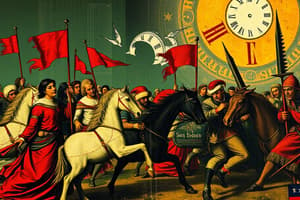Podcast
Questions and Answers
When did the Battle of San Jacinto take place?
When did the Battle of San Jacinto take place?
April 21, 1836
Which of the following were included in the Treaty of Velasco? (Select all that apply)
Which of the following were included in the Treaty of Velasco? (Select all that apply)
- Fighting would cease (correct)
- Mexico would no longer wage war against Texas (correct)
- Texas would receive a diplomat from Mexico (correct)
- Mexican armies would remain in Texas
Texas had a functioning government at the time of its independence.
Texas had a functioning government at the time of its independence.
False (B)
Who was the President of the Republic of Texas during its interim government?
Who was the President of the Republic of Texas during its interim government?
What significant event happened on March 2, 1836?
What significant event happened on March 2, 1836?
What capital city did Mirabeau Bonaparte Lamar move to in Texas?
What capital city did Mirabeau Bonaparte Lamar move to in Texas?
The Republic of Texas declared independence from ______.
The Republic of Texas declared independence from ______.
What were some problems faced by the Republic of Texas? (Select all that apply)
What were some problems faced by the Republic of Texas? (Select all that apply)
What was the purpose of the Santa Fe Expedition?
What was the purpose of the Santa Fe Expedition?
The Mier Expedition was successful in capturing additional territory for Texas.
The Mier Expedition was successful in capturing additional territory for Texas.
What was a main factor in the U.S. perspective for the annexation of Texas?
What was a main factor in the U.S. perspective for the annexation of Texas?
Flashcards are hidden until you start studying
Study Notes
Battle of San Jacinto & Treaty of Velasco
- The Battle of San Jacinto, fought on April 21, 1836, resulted in Texan victory and the capture of Mexican General Santa Anna.
- The Treaty of Velasco, signed afterward, stipulated a Mexican army withdrawal south of the Rio Grande, and Mexican recognition of Texas independence. Santa Anna pledged to lobby for this recognition in Mexico.
- Despite the treaty, many Texian soldiers favored executing Santa Anna. Sam Houston opted for a diplomatic approach.
The Republic of Texas: Formation & Challenges
- Texas initially lacked a formal government, capital, and treasury following independence.
- The Washington-on-the-Brazos Convention drafted a constitution and established an interim government on March 17, 1836.
- David G. Burnet served as interim President, and Lorenzo de Zavala as Vice-President. Their powers included negotiating treaties, developing a navy, and raising an army.
- The interim government faced a significant debt ($1.25 million) and struggled to pay officials and soldiers. They resorted to raising taxes and printing paper money.
Republic of Texas: Leadership & Politics
- Sam Houston became President in October 1836, with Mirabeau B. Lamar as Vice-President. Other key figures included Stephen F. Austin (Secretary of State) and Thomas J. Rusk (Secretary of War).
- The Republic faced ongoing border disputes with Mexico and financial instability. It struggled to maintain control over its army and pay debts. To alleviate this, it furloughed most of its soldiers, except 600.
- The fledgling government also struggled with internal issues, including managing and funding conflicts with Native American tribes.
Republic of Texas: Lamar's Presidency & Foreign Relations
- Mirabeau B. Lamar opposed Houston's policies and became president after Houston’s term.
- Lamar's administration pursued aggressive policies toward Native Americans, launching costly campaigns.
- Unsuccessful efforts were made by Lamar's administration in securing Mexican recognition of Texan independence, and securing a large loan. He attempted to address this with increased taxation.
- His administration was marked by fiscal challenges and limited success in foreign relations. The Santa Fe Expedition (1841) ended in failure. Further, the Republic's attempts to secure recognition from Mexico proved unsuccessful.
- Several military expeditions, including the Santa Fe Expedition and Mier Expedition, resulted in Texan prisoners of war in Mexico. The Mier Expedition ended with some Texans being executed by the Mexican government. This angered Texans and intensified the desire for annexation to the United States.
Annexation to the United States
- The annexation of Texas to the United States in 1845 addressed Texas’s ongoing security and financial concerns.
- Annexation was driven by various factors, including Manifest Destiny, expanding slavery, and British influence.
- Texas became the 28th state on December 29, 1845. The annexation resulted in Texas ceding certain territories to the United States and receiving assistance resolving the public debt.
- Disagreements persisted between Mexico and Texas concerning the border, particularly focusing on the Nueces River and the Rio Grande. This disagreement became a key issue that ultimately led to the Mexican-American War.
Studying That Suits You
Use AI to generate personalized quizzes and flashcards to suit your learning preferences.




